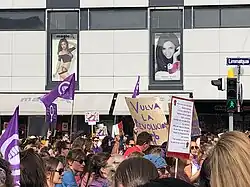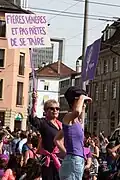2019 Swiss women's strike
The 2019 Swiss women's strike (German: Frauenstreik, French: Grève des Femmes) was a nationwide feminist strike action that took place in Switzerland on 14 June 2019. An estimated 500,000 people participated across the country, making it one of the largest demonstrations in recent Swiss history.[1][2]
The strike was held exactly 28 years after the 1991 Swiss women's strike.[3] Protesters demanded equal pay, recognition of unpaid care work, protection from sexual and physical harassment, and greater representation in government.[1] Demonstrations took place in major cities including Bern, Zurich, Basel, Geneva, and Lausanne, with participants wearing purple—a color associated with women's suffrage movements—and displaying the female symbol ♀ with a raised fist.[1][2]


Background
Gender inequality in Switzerland
At the time of the 2019 strike, Switzerland faced significant gender disparities across multiple areas. According to the Federal Statistical Office, women earned on average 19% less than men in 2018,[4] with 45.4% of this wage gap remaining unexplained by structural factors such as position, experience, or education. The median wage gap was 11.5%.[5]
Women also bore a disproportionate burden of unpaid domestic work, dedicating 28 hours per week to household tasks compared to 18 hours for men, according to 2016 data.[6] This inequality contributed to higher poverty rates among women (8.5%) than men (6.5%).[7] A 2019 survey found that 22% of Swiss women aged 16 and older had experienced non-consensual sexual acts.[8]
Legislative context
The 2019 strike was partly organized in response to the 2018 revision of Switzerland's 1996 Federal Act on Gender Equality, which trade unions criticized for failing to include sanctions for wage discrimination. This legislative disappointment helped galvanize support for renewed protest action.[9]
The strike also occurred within the context of international feminist movements, including the Women's March in the United States, Spain's feminist strikes, and the Me Too movement.[10][11]
History and precedents
The 2019 strike built upon a long history of Swiss women's rights activism:[12]
- 1928, 1958: Swiss exhibitions for Women's Work (SAFFA) highlighted women's economic contributions
- 1959: Introduction of women's voting rights in Vaud and Neuchâtel cantons
- 1971: Swiss women gained federal voting rights, among the last in Europe
- 1981: Gender equality was enshrined in the Swiss Constitution on 14 June
- 1985: Women gained the right to work and open bank accounts without spousal permission[4]
- 1991: The first women's strike on 14 June involved approximately 500,000 participants[3]
- 1996: Federal Act on Gender Equality was enacted
- 2002: Decriminalization of abortion for up to 12 weeks after pregnancy
- 2005: Maternity leave was introduced
The choice of 14 June as the strike date honored both the 1991 strike and the 1981 constitutional amendment on gender equality.
Organization and preparation
Planning for the 2019 strike began in January 2018, when the Women's Congress of the Swiss Trade Union Federation passed a resolution supporting a new women's strike. Feminist Assemblies held in Lausanne on 2 June 2018 formally approved the strike principle, launching a year-long campaign.[13]
On 22 September 2018, approximately 20,000 people demonstrated in Bern for wage equality, building momentum for the June 2019 action.[13] Organizers published a manifesto in January 2019 outlining 19 points justifying the strike.[13]
The strike was coordinated by various cantonal, regional, and local collectives across Switzerland, united under the slogan "Equality. Full stop!" (German: Gleichberechtigung. Punkt. Schluss!).[7]
Events of 14 June 2019
The strike featured two coordinated national moments: at 11:00 AM, the call for strike was read simultaneously across Swiss cities, and at 3:24 PM, women were invited to leave their workplaces or homes.[14] The 3:24 PM timing symbolically represented when women effectively stop being paid during an eight-hour workday, based on the wage gap calculated by federal statistics.[15]
In major cities, demonstrations took various forms. In Bern, members of parliament interrupted their session for 15 minutes in symbolic support, with many joining protesters in the Federal Square.[16] Protesters wore purple clothing and carried signs with the female symbol ♀ containing a raised fist. Some controversial symbols were also displayed, including representations of female anatomy, which organizers described as powerful symbols of femininity.[1]
The day concluded at midnight when Lausanne Cathedral was illuminated in purple, serving as a final symbolic gesture.[1]
Participation by city
Estimates of participation varied, with organizers and police sometimes providing different figures:[17][18]
- Basel: 40,000 people[14]
- Bern: 50,000 people[14]
- Geneva: 20,000 (police estimate) to 75,000 (algorithm-based count by EPFL)[18]
- Lausanne: 40,000 (police) to 60,000 (organizers)[18]
- Zurich: 160,000 (revised police estimate)[18]
- Smaller cities: Aarau (3,000), Delémont (4,000), Fribourg (12,000), Neuchâtel (5,000), Sion (12,000), St. Gallen (4,000)[14][15]
-
 Demonstration in Biel/Bienne, with women holding up signs.
Demonstration in Biel/Bienne, with women holding up signs.
Influence
In the 2019 federal elections, women's representation in the National Council reached a historic high of 42%, compared to 32% in 2015.[19] The parties electing the highest proportion of women were the Social Democratic Party (62%) and the Green Party (61%).[20]
The Swiss Parliament introduced two-week paternity leave, expanding from the previous single day.[21] Despite opposition from the Swiss People's Party and some members of other parties,[22] Swiss voters approved the paternity leave by 60.3% in a referendum on 27 September 2020, with the policy taking effect on 1 January 2021.[23]
The success of the 2019 strike established 14 June as an annual day of feminist action in Switzerland.[24] Subsequent strikes were held in 2020 (despite the COVID-19 pandemic), 2021,[25] 2022,[26] and 2023, maintaining the date as a fixture in Swiss feminist activism[27] and permanently transforming the country's feminist landscape.[28]
References
- ^ a b c d e Cumming-Bruce, Nick; Schaverien, Anna (14 June 2019). "Swiss Women Strike Nationwide to Protest Inequalities". The New York Times. ISSN 0362-4331. Retrieved 21 March 2023.
- ^ a b Kennedt, Merrit (14 June 2019). "'Wages. Time. Respect': Swiss Women Go On Strike". NPR. Retrieved 20 March 2023.
- ^ a b Gallin, Dan (1 January 1991). "Women's Strike in Switzerland". Agenda. 7 (11): 28–29. doi:10.1080/10130950.1991.9675153. ISSN 1013-0950.
- ^ a b Henley, Jon (14 June 2019). "Swiss women strike to demand equal pay". The Guardian. ISSN 0261-3077. Retrieved 21 March 2023.
- ^ "Écart salarial entre hommes et femmes". Office fédéral de la statistique (in French). Retrieved 4 July 2022.
- ^ "Nombre d'heures consacrées au travail domestique et familial en 2016". Office fédéral de la statistique (in French). Retrieved 14 June 2019.
- ^ a b "Grève des femmes du 14 juin 2019 (dossier et liens)". rts.ch (in French). RTS Info. 14–15 June 2019. Retrieved 15 June 2019.
- ^ "Une femme sur cinq a déjà subi des violences sexuelles en Suisse". rts.ch (in French). 21 May 2019. Retrieved 4 July 2022.
- ^ "En Suisse, les femmes appelées à la grève pour dénoncer les inégalités". Le Monde (in French). 14 June 2019. Retrieved 14 June 2019.
- ^ Sophie Guignard (10 March 2019). "Grève féministe et des femmes* du 14 juin 2019". Année politique suisse (in French). Retrieved 10 June 2023.
- ^ "Grève des femmes*/féministe: le 14 juin 2019, tou·te·s en grève!". solidarites.ch. 3 May 2019. Retrieved 10 June 2023..
- ^ Abplanalp, Andrej (14 June 2019). "The women's strike day of 1991". Swiss National Museum - Swiss history blog. Retrieved 21 March 2023.
- ^ a b c "Les organisatrices de la grève des femmes publient leur manifeste". letemps.ch (in French). Retrieved 16 June 2019.
- ^ a b c d "Grève des femmes : les Suissesses se sont mobilisées en masse partout dans le pays". lenouvelliste.ch (in French). Retrieved 16 June 2019.
- ^ a b "Des centaines de milliers de femmes ont pris part à la grève nationale". rts.ch (in French). Retrieved 16 June 2019.
- ^ "Suisse : des centaines de milliers de femmes dans la rue pour réclamer l'égalité salariale". Le Monde (in French). 14 June 2019. Retrieved 17 June 2023.
- ^ "Le comptage des manifestantes de la grève des femmes fait polémique". rts.ch (in French). 17 June 2019. Retrieved 3 June 2021.
- ^ a b c d Frammery, Catherine (17 June 2019). "20 000 manifestantes dans les rues de Genève: le chiffre qui fait tousser". Le Temps (in French). Retrieved 3 June 2021.
- ^ Tombez, Valentin (22 October 2019). "Percée historique des femmes au Conseil national". RTS Info.
- ^ Wuthrich, Bernard. "Un parlement plus féminin et plus académique". Le temps.
- ^ Romy, Katy (14 June 2020). "Un an après la grève, les femmes ont marqué des points". Swiss Info.
- ^ "Le peuple votera sur le congé paternité, le référendum a abouti". rts.ch (in French). 5 February 2020. Retrieved 13 August 2025.
- ^ "Un congé paternité de deux semaines va être introduit en Suisse". rts.ch (in French). 27 September 2020. Retrieved 13 August 2025.
- ^ Katy Romy (14 June 2020). "Un an après la grève, les femmes ont marqué des points". swissinfo (in French). Retrieved 7 June 2023.
- ^ "Vague violette et minutes de silence, les femmes dans la rue pour l'égalité". rts.ch (in French). 14 June 2021. Retrieved 13 August 2025.
- ^ "La Grève féministe mobilise 50'000 personnes dans les rues de Suisse". rts.ch (in French). 14 June 2022. Retrieved 13 August 2025.
- ^ "Revivez «Le Débat» consacré à la grève féministe du 14 juin - Le Temps" (in French). 7 June 2023. ISSN 1423-3967. Retrieved 13 August 2025.
- ^ Dominique Hartmann (4 June 2023). "14 juin, un mouvement de fond". Le Courrier (in French). Retrieved 7 June 2023.
External links
![]() Media related to Women's strike of 14 June 2019 in Switzerland at Wikimedia Commons
Media related to Women's strike of 14 June 2019 in Switzerland at Wikimedia Commons